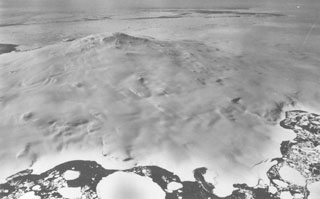Report on Siple (Antarctica) — September 1988
Scientific Event Alert Network Bulletin, vol. 13, no. 9 (September 1988)
Managing Editor: Lindsay McClelland.
Siple (Antarctica) Apparent ash plumes detected by satellite imagery
Please cite this report as:
Global Volcanism Program, 1988. Report on Siple (Antarctica) (McClelland, L., ed.). Scientific Event Alert Network Bulletin, 13:9. Smithsonian Institution. https://doi.org/10.5479/si.GVP.SEAN198809-390025
Siple
Antarctica
73.43°S, 126.67°W; summit elev. 3110 m
All times are local (unless otherwise noted)
Apparent ash plumes from Mt. Siple were detected by NOAA 10 satellite imagery (visible band, orbit 10406) on 18 September at 1301 and again on 4 October at 1534 (infrared and visible bands, orbit 10636). The 4 October plume extended ~160-170 km WNW and was well-defined, but it was uncertain whether the plume originated from the volcano's summit or base [but see 13:12]. A review of past LANDSAT images indicated a possible February 1988 ash deposit on the ice near the volcano. Michael Matson and George Stephens are currently applying additional satellite data aquisition and reduction techniques to refine these interpretations.
. . . Geologists hope to visit the volcano in November.
Geological Summary. Mount Siple is a shield volcano that forms an island along the Pacific Ocean coast of Antarctica's Marie Byrd Land. The massive 1,800 km3 volcano is truncated by a 4-5 km summit caldera and is ringed by tuff cones at sea level. A possible eruption cloud observed on satellite images on 18 September and 4 October 1988 was considered to result from atmospheric effects, after low-level aerial observations revealed no evidence of recent eruptions. Trachytic rocks at the summit have been Ar-Ar dated to about 227,000 and 169,000 years old.
Information Contacts: W. Gould, M. Matson, and G. Stephens, NOAA; W. LeMasurier, Univ of Colorado.

